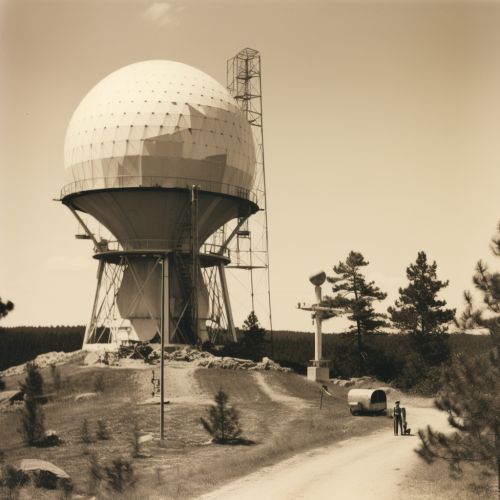Weather radar
Introduction
Weather radar, also known as meteorological radar, is a type of radar used to locate precipitation, calculate its motion, and estimate its type (rain, snow, hail, etc.). Modern weather radars are mostly pulse-Doppler radars, capable of detecting the motion of rain droplets in addition to the intensity of the precipitation.


History
The first practical weather radar system was constructed in 1940 by the U.S. Army Signal Corps. This radar was able to detect the presence of precipitation at a range of 100 miles. The development of weather radar has roots in World War II technology. During the war, military radar operators discovered that weather was causing echoes on their screen, masking potential enemy targets. Techniques were developed to filter them, but scientists began to study the phenomenon. After the war, surplus radars were used to detect precipitation.
Principles of Operation
Weather radars send out a pulse of electromagnetic energy and listen for any returned signal. The strength of the return signal is proportional to the number and size of the scatterers (rain, snow, etc.) in the pulse volume. The time it takes for the pulse to return to the radar is used to calculate the distance to the precipitation.
Types of Weather Radar
Pulse-Doppler Radar
Pulse-Doppler radar systems determine the velocity of precipitation particles by analyzing the change in phase of successive radar pulses. This allows them to accurately measure the speed at which rain or snow is moving along the radar beam, a critical factor in weather forecasting.
Dual-Polarization Radar
Dual-polarization radar systems transmit and receive pulses in both horizontal and vertical orientations. This allows them to infer more information about the size and shape of the precipitation particles, which can help to distinguish between different types of precipitation.
Phased Array Radar
Phased array radar systems use a large number of small antennas to steer the radar beam electronically, rather than mechanically. This allows them to scan the sky more quickly and accurately, providing more timely weather updates.
Applications
Weather radar has a wide range of applications, from weather forecasting and severe storm tracking to aviation and climate research. In weather forecasting, radar data can provide detailed information on storm location, intensity, and movement. This can help forecasters to predict severe weather events such as thunderstorms, tornadoes, and hurricanes.
In aviation, weather radar is used to detect and avoid hazardous weather conditions. Pilots can use radar data to navigate around areas of heavy precipitation, reducing the risk of aircraft damage and improving passenger safety.
In climate research, long-term radar data can be used to study changes in precipitation patterns, contributing to our understanding of global climate change.
Limitations and Challenges
While weather radar is a powerful tool, it is not without its limitations. For example, radar beams can be blocked by mountains or tall buildings, creating "shadows" where no data is available. Additionally, the radar beam becomes more elevated with distance from the radar, which can limit its ability to detect low-level precipitation.
Another challenge is the interpretation of radar data. Different types of precipitation can produce similar radar echoes, making it difficult to distinguish between them. Furthermore, non-weather targets such as birds, insects, and ground clutter can also produce echoes, which can complicate the interpretation of radar data.
Future Developments
Advancements in radar technology and computing power are expected to lead to significant improvements in weather radar in the future. For example, the development of multi-function phased array radar (MPAR) could provide more accurate and timely weather data by scanning the sky in multiple directions simultaneously.
Additionally, improvements in data processing and interpretation techniques could help to overcome some of the current limitations of weather radar, enhancing its utility in weather forecasting and climate research.
